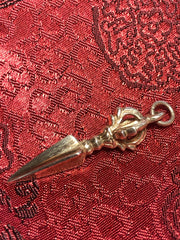



🖐 Handmade in Nepal
😇 22 Years of Service in Retail
😍 Thank you for your Support n Love 🙏
Silver Phurba/Kila Pendant Length 1.5”
The kīla or phurba (Sanskrit Devanagari: कील; IAST: kīla; Tibetan: ཕུར་པ or ཕུར་བ, Wylie: phur ba,[needs IPA] alternate transliterations and English orthographies: phurpa, phurbu, purbha, or phurpu) is a three-sided peg, stake, knife, or nail-like ritual implement traditionally associated with Indo-Tibetan Buddhism, Bön, and Indian Vedic traditions.[citation needed]
The kīla is associated with the practice of the yidam (Sanskrit ishtadevata, Tibetan yidam) or meditational deity Vajrakīla (वज्रकील) or Vajrakīlaya (Tibetan Dorje Phurba).
The ritual dagger (Sanskrit: kila; Tibetan: phurba) is essential to the dispelling of evil and understood as being especially helpful in neutralizing the forces that impede Tantric Buddhist practice. Its origins are ancient, appearing in the Indian Rg Veda as the central blade of the vajra that Indra used to slay the primordial cosmic snake Vritra. Its Sanskrit term, kila, which means peg or stake, was probably linked to Vedic sacrifices. The three-headed Vajrakila Buddha is invoked through meditation on the Vajrakila Tantra, an early Indian text first propagated in Tibet in the eighth century by Padmasambhava, one of the founding masters of Tibetan Buddhism. In this phurba, a half-vajra projects from Vajrakila's chignon, and a fully elaborated vajra serves as the hilt, below which project boars' heads. Rock crystal, valued for its purity and ability to transmit light, is a prized material in this context and thus seen as analogous to the Buddha's dharma and its immutable higher reality. Along with examples in meteoritic iron, rock-crystal phurba are regarded as the most efficacious in the destruction of obstacles to enlightenment.
*SHIPS FAST AND SECURE FROM BOULDER COLORADO, UNITED STATES.*
